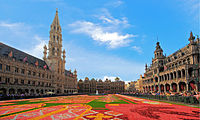
Photo from wikipedia
Within both the South African and Belgian contexts whiteness manifests as one aspect of national identity and remains (to differing degrees) a normative construction. This article presents the findings of… Click to show full abstract
Within both the South African and Belgian contexts whiteness manifests as one aspect of national identity and remains (to differing degrees) a normative construction. This article presents the findings of a controlled case comparison of a sample from two community soap operas, 7de Laan and Thuis , broadcast by the South African (SABC) and Flemish (VRT) Public Service Broadcasters respectively, from the perspective of critical whiteness studies. I contend that whiteness functions as an organising principle in the narratives of both soap operas. The goal of this comparative analysis was an investigation into the ways in which whiteness is constructed and positioned in these texts and the implications this has for the politics of belonging. Despite several similarities between the two contexts, they differ significantly, and this created an opportunity to highlight both the consistencies and particularities in the ideological patterning of representations of whiteness, across seemingly unrelated domains, to illustrate its pervasiveness. Notwithstanding their disparate origins, the analysis revealed three rhetorical devices which function to maintain whiteness as hegemonic ideology in both texts. Keywords: 7de Laan , critical whiteness studies, community soap opera. controlled case comparison, politics of belonging, Thuis , whiteness
Journal Title: Tydskrif Vir Letterkunde
Year Published: 2018
Link to full text (if available)
Share on Social Media: Sign Up to like & get
recommendations!